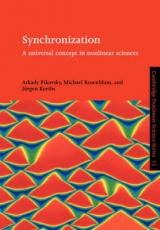
Synchronization
Cambridge University Press (Verlag)
978-0-521-59285-7 (ISBN)
- Titel erscheint in neuer Auflage
- Artikel merken
First recognized in 1665 by Christiaan Huygens, synchronization phenomena are abundant in science, nature, engineering and social life. Systems as diverse as clocks, singing crickets, cardiac pacemakers, firing neurons and applauding audiences exhibit a tendency to operate in synchrony. These phenomena are universal and can be understood within a common framework based on modern nonlinear dynamics. The first half of this book describes synchronization without formulae, and is based on qualitative intuitive ideas. The main effects are illustrated with experimental examples and figures, and the historical development is outlined. The remainder of the book presents the main effects of synchronization in a rigorous and systematic manner, describing classical results on synchronization of periodic oscillators, and recent developments in chaotic systems, large ensembles, and oscillatory media. This comprehensive book will be of interest to a broad audience, from graduate students to specialist researchers in physics, applied mathematics, engineering and natural sciences.
Arkady Pikovsky was part of the Max-Planck research group on nonlinear dynamics, before becoming a professor at the University of Potsdam, Germany. A member of the German and American Physical Societies, he is also part of the Editorial Board of Physical Reviews E for the term 2000-2002. Before this, he was a Humboldt fellow at University of Wuppertal. His PhD focusses on the theory of chaos and nonlinear dynamics, and was carried out at the Institute of Applied Physics of the USSR Academy of Sciences. Arkady Pikovsky studied radiophysics and physics at Gorky State University, and started to work on chaos in 1976, describing an electronic device generating chaos in his Diploma thesis and later proving it experimentally. Professor Michael Rosenblum has been a research associate in Department of Physics, Potsdam University since 1997. His main research interests are the application of oscillation theory and nonlinear dynamics to biological systems and time series analysis. He was a Humboldt fellow at the Max-Planck research group on non-linear dynamics, and a visiting scientist at Boston University. Professor Rosenblum studied physics at Moscow Pedagogical University, and went on to work in the Mechanical Engineering Research Institute of USSR Academy of Sciences, obtaining a PhD in physics and mathematics. Jurgen Kurths has been professor at the University of Potsdam and director of the Interdisciplinary Centre for Nonlinear Dynamics since 1994. He is a fellow of the American Physical Society and fellow of the Fraunhofer Society (Germany), and is currently the chairman for Nonlinear Processes in Geophysics and member of the council in Geophysics of the European Geophysical Society. In 2001 he will be a member of the Editorial Board of the Int. J. of Bifurcation and Chaos. Professor Kurths was director of the group for Nonlinear Dynamics of the Max-Planck Society from 1992–1996. He studied mathematics at Rostock University, and then went on to work at the Solar-Terrestrial Physics Institute, and later the Astrophysical Institute of GDR Academy of Sciences. He obtained his PhD in Physics, and started to work on nonlinear data analysis and chaos in 1984. His main research interests are nonlinear dynamics and their applications to geophysics and physiology and to time series analysis.
Preface; 1. Introduction; Part I. Synchronization Without Formulae: 2. Basic notions: the self-sustained oscillator and its phase; 3. Synchronization of a periodic oscillator by external force; 4. Synchronization of two and many oscillators; 5. Synchronization of chaotic systems; 6. Detecting synchronization in experiments; Part II. Phase Locking and Frequency Entrainment: 7. Synchronization of periodic oscillators by periodic external action; 8. Mutual synchronization of two interacting periodic oscillators; 9. Synchronization in the presence of noise; 10. Phase synchronization of chaotic systems; 11. Synchronization in oscillatory media; 12. Populations of globally coupled oscillators; Part III. Synchronization of Chaotic Systems: 13. Complete synchronization I: basic concepts; 14. Complete synchronization II: generalizations and complex systems; 15. Synchronization of complex dynamics by external forces; Appendix 1. Discovery of synchronization by Christiaan Huygens; Appendix 2. Instantaneous phase and frequency of a signal; References; Index.
| Erscheint lt. Verlag | 18.10.2001 |
|---|---|
| Reihe/Serie | Cambridge Nonlinear Science Series |
| Zusatzinfo | 9 Halftones, unspecified; 213 Line drawings, unspecified |
| Verlagsort | Cambridge |
| Sprache | englisch |
| Maße | 181 x 255 mm |
| Gewicht | 1030 g |
| Themenwelt | Mathematik / Informatik ► Informatik ► Theorie / Studium |
| Naturwissenschaften ► Physik / Astronomie | |
| ISBN-10 | 0-521-59285-2 / 0521592852 |
| ISBN-13 | 978-0-521-59285-7 / 9780521592857 |
| Zustand | Neuware |
| Haben Sie eine Frage zum Produkt? |
aus dem Bereich



